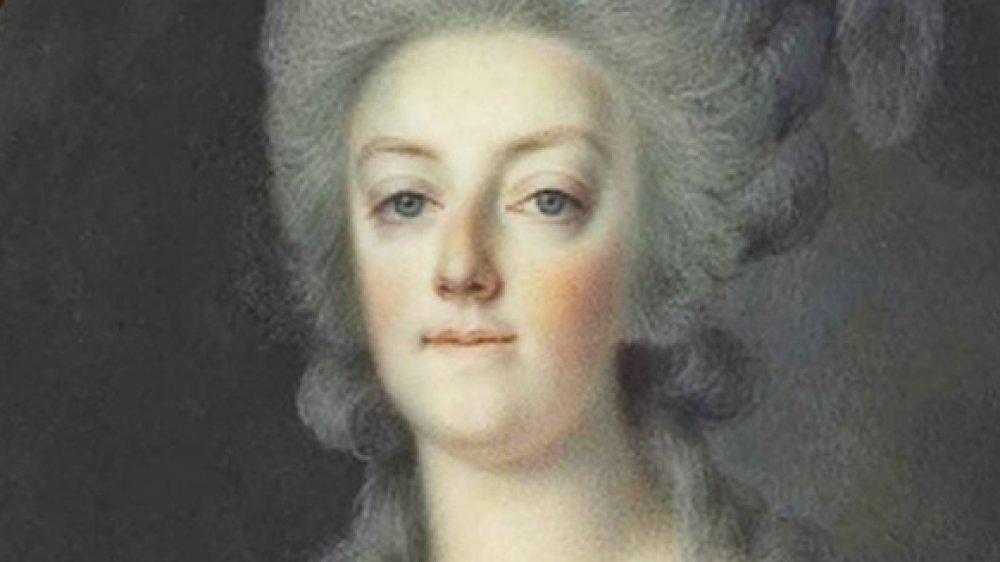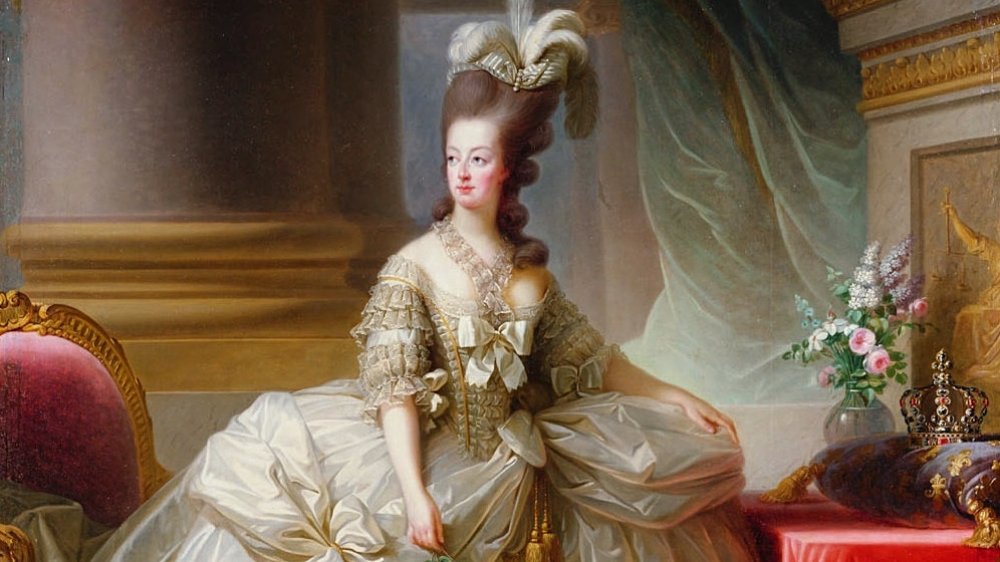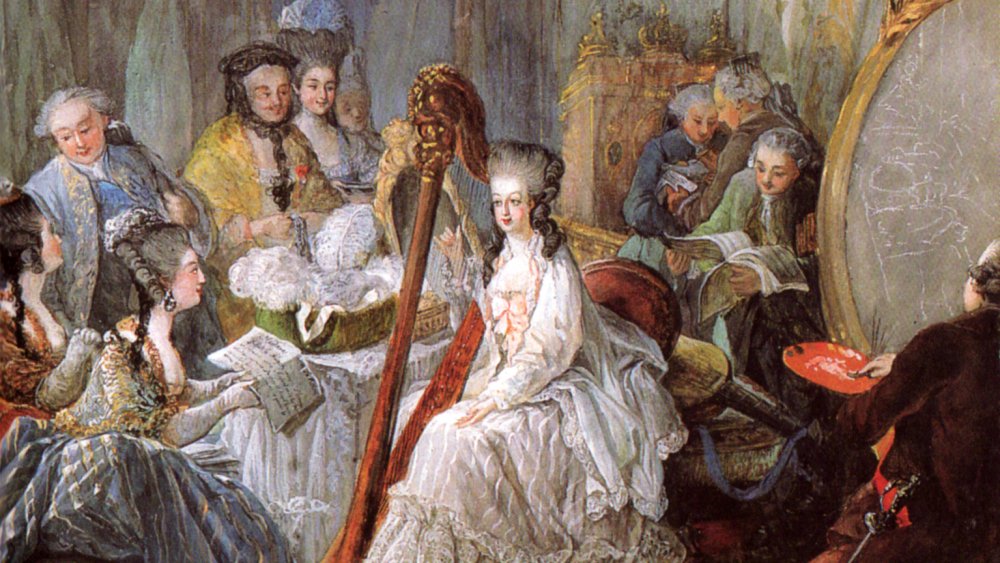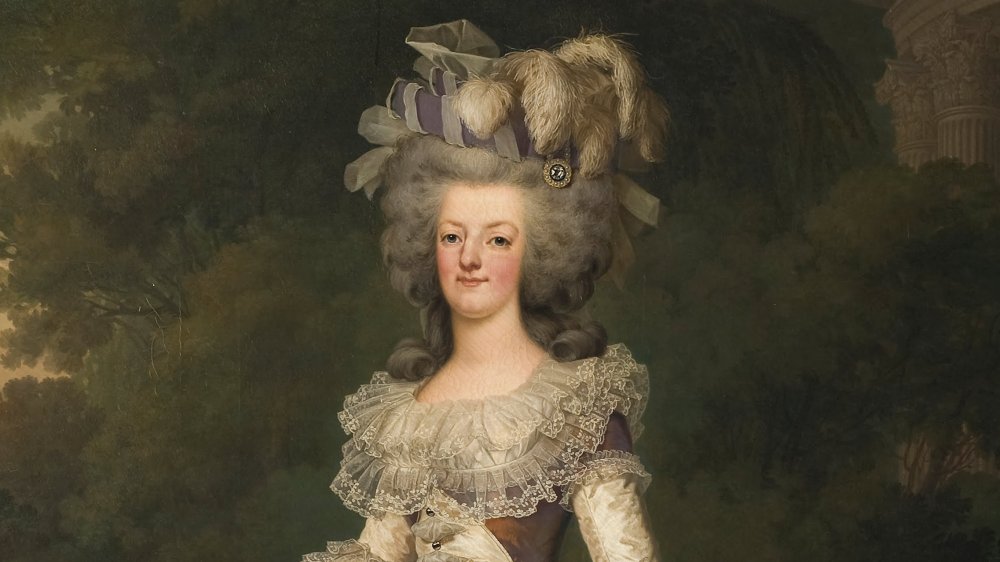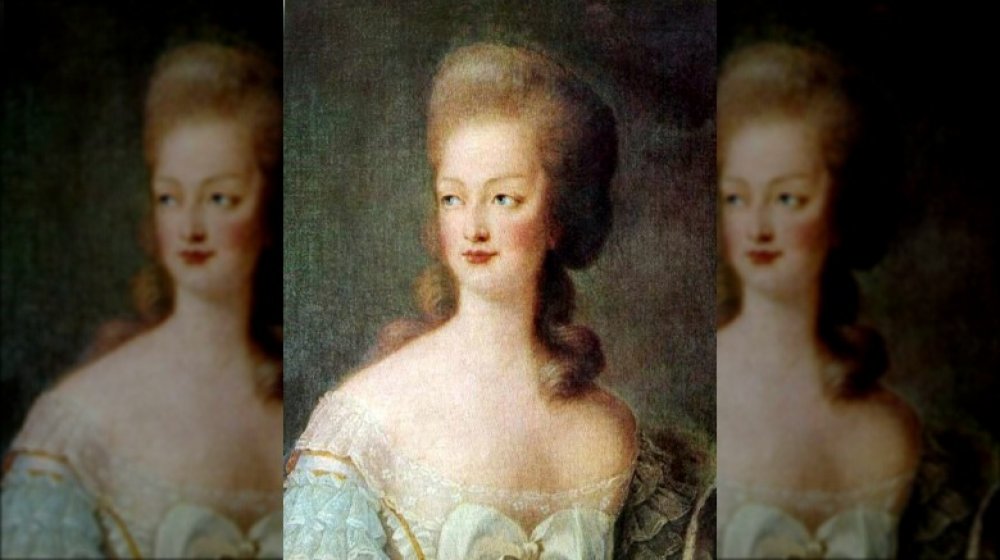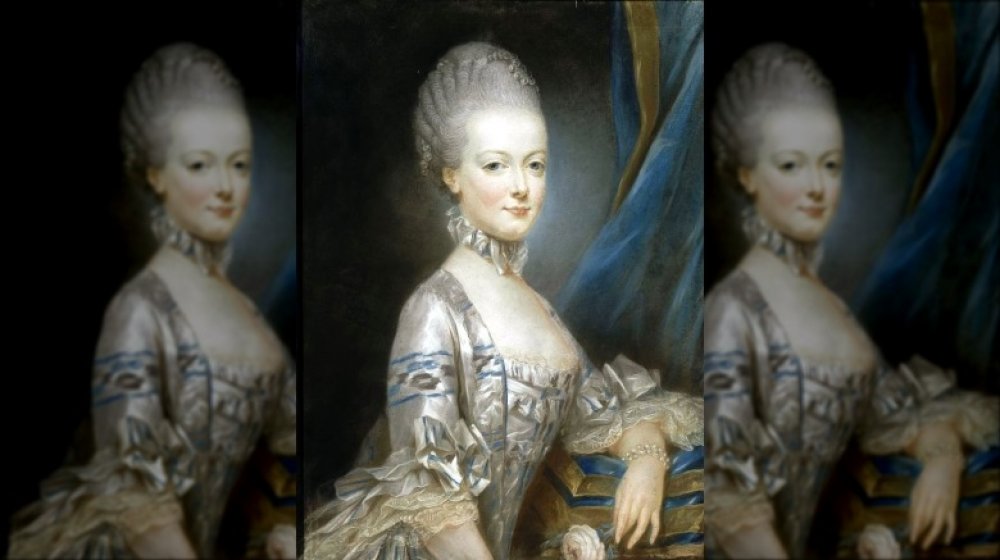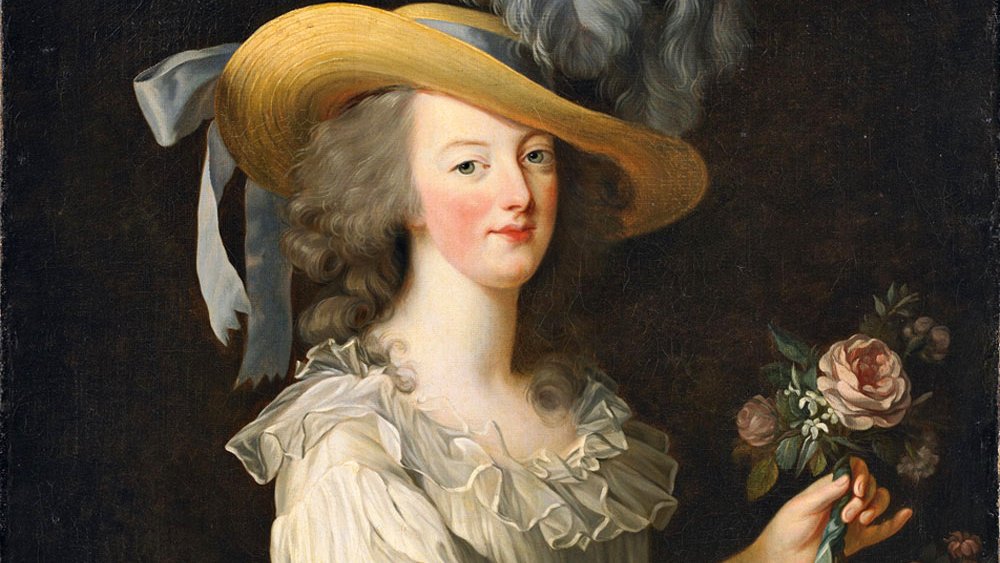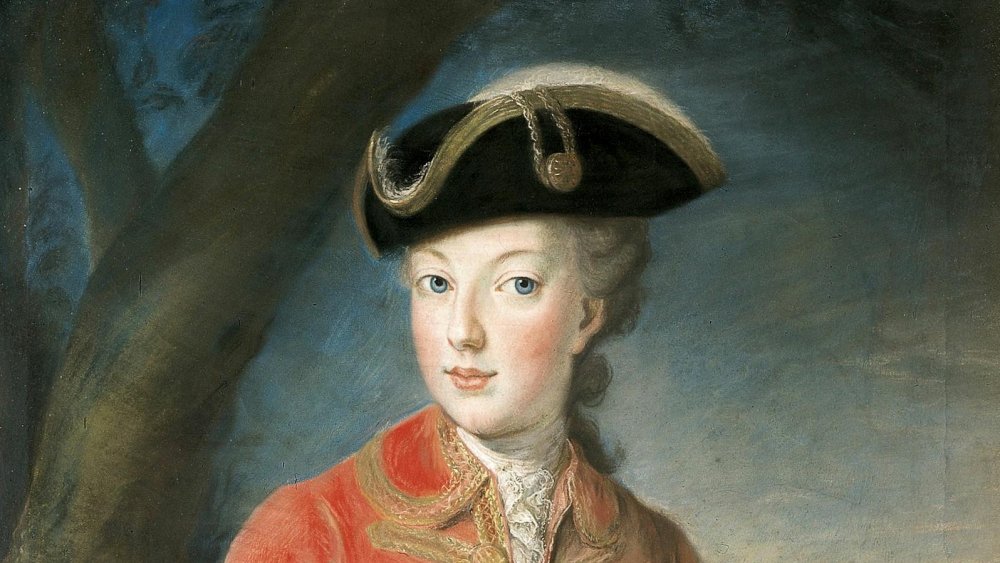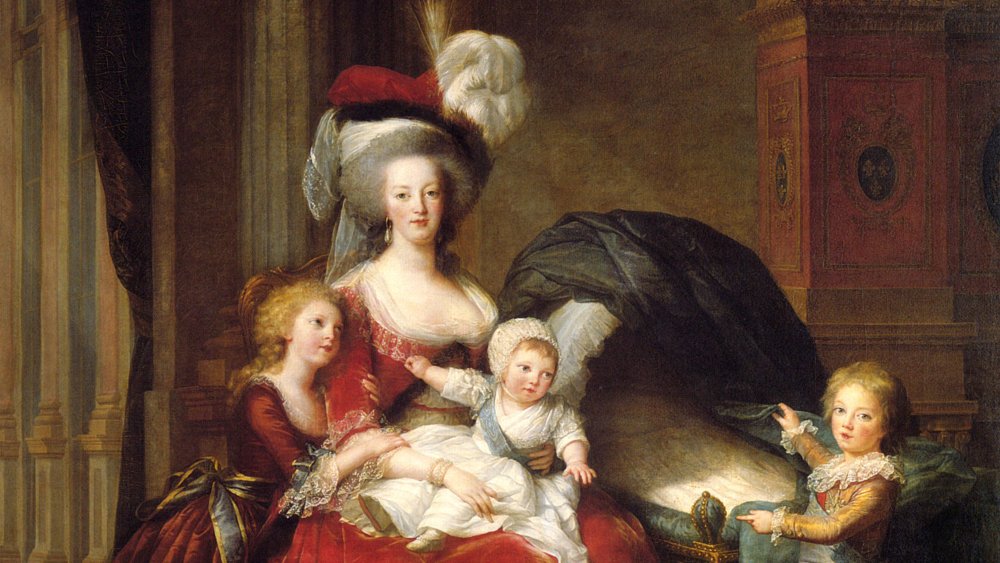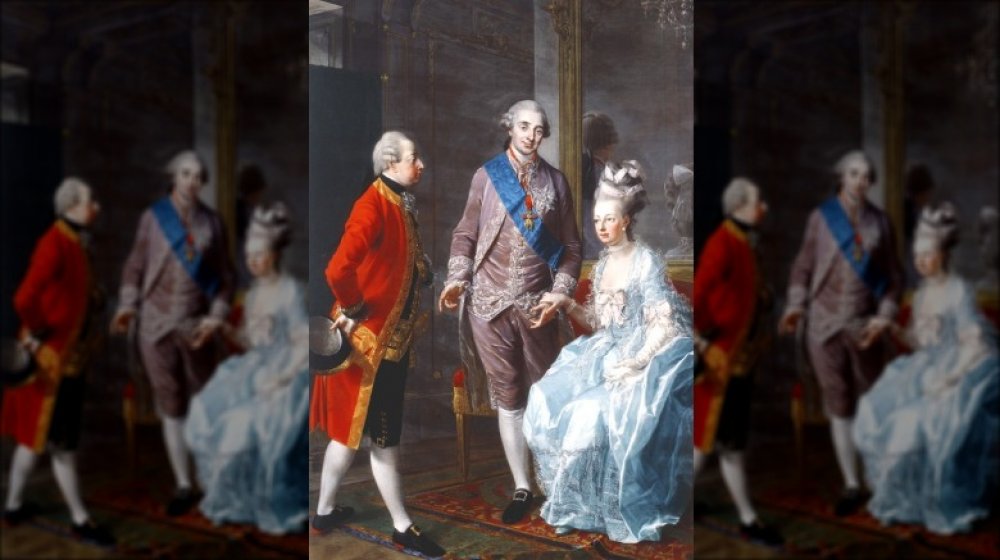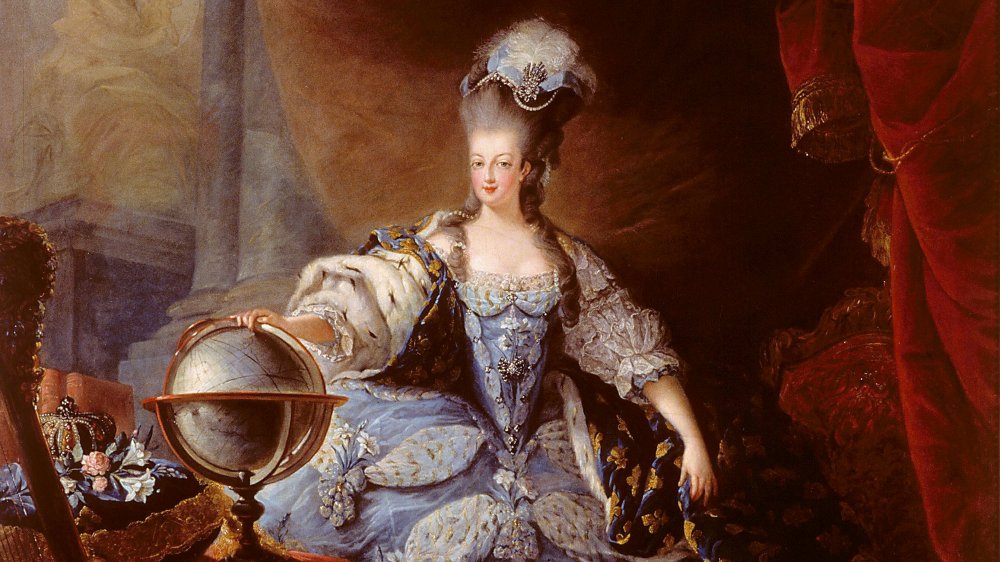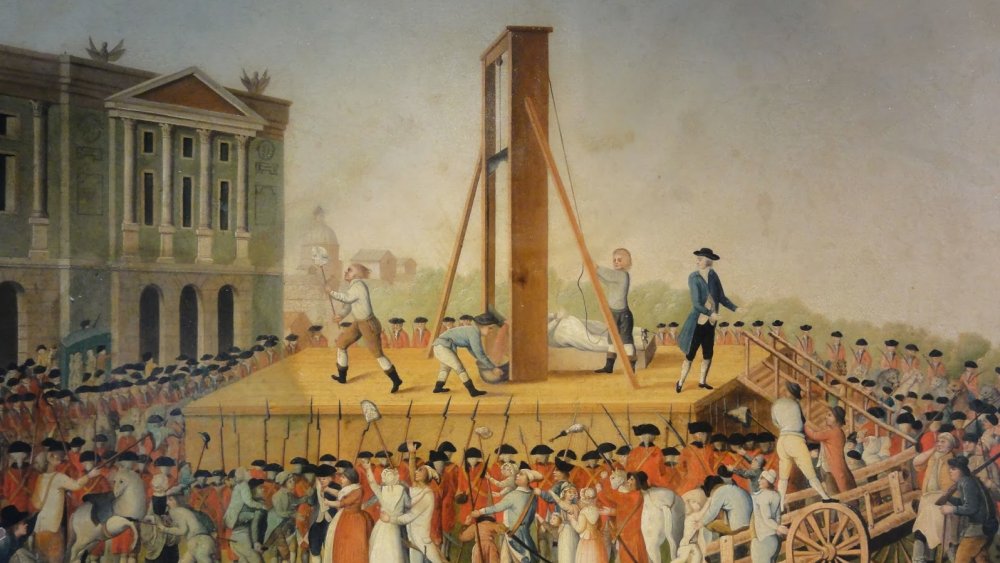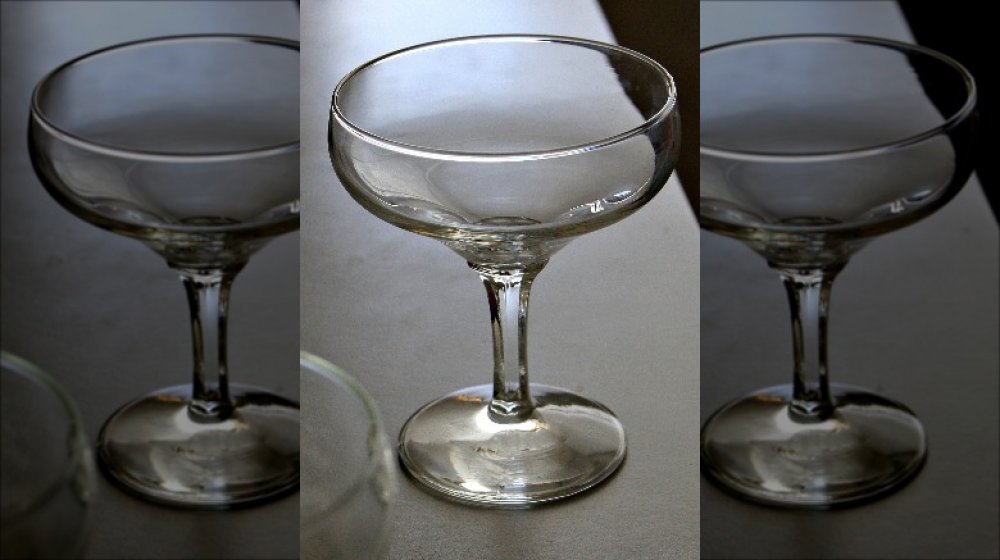Myths You Believe About Marie Antoinette
Marie Antoinette was the last queen of France before the French Revolution, and for more than 200 years she has stood as the ultimate example of a cold, careless aristocrat, living a life of luxury as thousands starved to death around her. She, perhaps even more than her husband, King Louis XVI, is associated with losing her head at the guillotine for her heartless disregard of the suffering of the impoverished people of France. The image of a powdered wig-wearing, bonbon-chomping, fainting couch sprawling libertine in an enormous dress has clung to Marie Antoinette since her final days. But how much of it is true?
Setting aside the question of whether monarchy as an institution is good or not (it's not), let's take a look at some of the more pervasive charges laid against Marie Antoinette both by the revolutionary tribunal and by history at large. Here are some false things you might believe about the last queen of France.
'Let them eat cake'
Let's take a look at the most obvious myth about Marie Antoinette. Even if you're barely aware of the last queen of France, chances are good that you've heard two things about her: her last dance on this Earth was with Madame Guillotine and she said, "Let them eat cake." You might be unsure of what this phrase even means, devoid of context. Was she officiating at a child's birthday party or a wedding? Well, as the story goes, someone informed the queen that the peasants of France were starving because they had no bread. The famous quote is supposed to have been her oblivious and privilege-clouded response.
However, as National Geographic points out, she never actually said this. This specific anecdote of an uncaring queen not understanding common people's hardships predates Marie Antoinette's time by decades and was attributed to a number of foreign queens before her. In fact, the original phrase comes from a probably fictional anecdote recounted by philosopher Jean-Jacques Rousseau, though some believe he may have been referring to Maria Theresa, the Spanish-born queen married to King Louis XIV. Also, the original phrase was "qu'ils mangent de la brioche," or "let them eat brioche," an egg-based bread, not cake. As with most myths about Marie Antoinette, this one was fabricated by one of her many political enemies to worsen her reputation among the impoverished people of France.
Marie Antoinette was heartless toward the poor
The point of the famous "let them eat cake" story is to illustrate Marie Antoinette's alleged disdain for the poor. The popular image of the queen among revolutionaries–and, indeed, even today–is that she was an uncaring aristocrat, more powdered wig than brain or heart, whose view from the ivory tower of Versailles kept her from seeing, understanding, or caring about the suffering of the downtrodden. By all actual historical accounts, however, this couldn't be further from the truth. Despite the fact that she did have something of a spendthrift nature, as Mental Floss explains, she was also exceedingly kind and generous.
For example, she established a home for unwed mothers and gave food to the starving (presumably including the bread she was supposed to be unconcerned about). When a famine hit in 1787, she sold her own royal flatware to buy grain for those in need. At another time, when a man was accidentally struck by her carriage, she paid for his medical care and supported his family until he was in good health again. Other accounts attest to her taking care of a peasant who had been wounded by a wild animal, as well as taking in a young boy who had been orphaned. Even without the objective evidence that Marie Antoinette was not the origin of the "cake" sentiment, actions like these make it clear such a statement wasn't in her nature.
She was an ice queen
The image of Marie Antoinette as disdainful of and apathetic toward the suffering of the poor is just part of a larger trend among the queen's enemies to portray her as an unfeeling, luxuriant aristocrat who expressed no concern over the feelings of others. This view was made particularly popular in the various pamphlets distributed in Antoinette's lifetime. These depicted her as having a voracious sexual appetite, which led her to use a long string of lovers for carnal pleasure and then disposing of them without a thought. One such pamphlet told of her conceiving a child from one of her affairs, which she subsequently murdered without mercy.
The York Historian says this depiction of Marie Antoinette as a heartless ice queen who exploits and then disposes of people for pleasure could not be further from the truth. Antoinette's personal letters show a person who feels emotion very strongly and is in fact incredibly concerned for the people around her. It was, perhaps, this very capacity for empathy that made her such an easy target for persecution from those who wanted to discredit her. Despite the fact that Antoinette was constantly accused of heinous crimes she hadn't committed, her final letter, smudged and stained with her own tears, is full of passionate pleading for forgiveness, both for herself and for those who so falsely and vehemently accused her.
Marie Antoinette was blonde
While it is perhaps most common for modern portrayals of Marie Antoinette to show her with her hair powdered white or wearing a white powdered wig, many popular depictions of the queen in film or on book covers tend to show her natural hair as being a golden blonde color. This is probably most notable in her portrayal by Kirsten Dunst in the 2006 film Marie Antoinette, but can also be seen in Joely Richardson's performance as Antoinette in 2001's The Affair of the Necklace or numerous modern mass market book covers, like 2011's Becoming Marie Antoinette. But while the powdered hair and ludicrous wigs might be accurate to history, evidence suggests the blonde part probably isn't.
As HuffPost explains, Madame du Barry, the mistress of King Louis XV and venerable foe of Antoinette at court, was known to refer to Marie Antoinette derisively as la petite rousse, "the little redhead." Other evidence seems to support a redheaded (or at least strawberry blonde) Marie Antoinette, including a locket-sized portrait of Antoinette by miniaturist Francois Dumont that depicts the queen with unambiguously ginger locks. While the deep redness in that portrait may have been exaggerated due to its tiny size, other portraits of the queen depict her with varying shades of gingery blonde hair, and samples of her locks such as an alleged example at the British Museum seem to support the "strawberry blonde" interpretation.
Marie Antoinette was French
If someone were to ask you who Marie Antoinette was, you might start by saying, "Well, she was a French queen..." and you would be wrong already. Yes, it's true she was the queen of France, but she wasn't French. That might seem like splitting hairs, but you know who else splits hairs? People with guillotines. And there's a good chance that a major reason Marie Antoinette got guillotined was precisely because she wasn't French.
According to Encyclopedia Britannica, Marie Antoinette was born under the much less French-sounding name of Maria Antonia Josepha Johanna von Österreich-Lothringen in German-speaking Austria. She was the youngest daughter of the Holy Roman Emperor Francis I and Empress Maria Theresa of the Hapsburg Empire. She was raised in Vienna until she was a teenager and was sent to marry the equally teenaged future-Louis XVI to end the long-running hostilities between the Austrians and the French. Such political marriages between nations was of course very common (compare, for example, Catherine the Great of Russia, who was actually Prussian, not Russian), but foreign-born queens had a bad reputation in France. The York Historian explains that Antoinette's status as a foreigner, and as an Austrian in particular, made her a convenient scapegoat for all of France's ills, and the French stereotype of Austrians as incestuous, brutish, and crude fed the fire of the rumors and libels spread about Antoinette by vicious pamphleteers.
She bankrupted France with her shopping
According to legend, American president Thomas Jefferson is alleged to have said that if it weren't for Marie Antoinette, there would have been no French Revolution. The implication of this observation is that the financial problems of the final days of the French monarchy were largely or even wholly due to the lavish spending of the queen, who was known for her expensive tastes in clothing and upgrades to the palace of Versailles. Her penchant for the extravagant led to her being nicknamed "Madame Deficit" by around 1786, and the idea that she spent France into the poorhouse has stuck since then.
However, as National Geographic points out, while Marie Antoinette may have had a taste for excess, that was the way of life at Versailles long before she got there, and she was just adopting the Versailles lifestyle. Furthermore, the French treasury was empty before Louis XVI and Marie Antoinette even took the throne, although Louis didn't make this situation any better when he decided to send troops to the US to aid in the Revolutionary War against the British. While it might have made Louis feel good to get revenge on Britain after having lost French colonies in Canada and the Caribbean to them in the Seven Years' War, sending military aid to the American colonies was an expensive choice that only dragged the already bankrupt France deeper into debt.
Marie Antoinette wore only the finest clothes
There is no arguing that Marie Antoinette had a passion for fashion. How Stuff Works records that the queen had some 300 dresses commissioned annually for her various social engagements throughout the year, plus her trademark high-pouf hairstyle, and a signature fragrance meant to evoke the scent of the gardens of her personal chateau on the grounds of Versailles. All of which helped to drain the national coffers and build up Marie Antoinette's reputation among the revolutionaries as "Madame Deficit."
However, this kind of spending on wardrobe was another example of Marie Antoinette simply adapting to the Versailles lifestyle. Prior to coming to the French court, Marie Antoinette's personal style was tomboyish, built around her hobbies of hunting and horseback riding. She didn't like dressing up fancily and being put on display in every facet of her day-to-day life, but such was the nature of a diplomatic marriage. Most of the letters Marie Antoinette received from her mother were about tidying up her slovenly appearance. Even then, Marie Antoinette shocked the nation with her tendency to dress down. She was criticized for wearing a simple white dress of her own design which made her not look fancy enough. Ironically, this white dress, simple and cheap to produce, would basically become the uniform of the same revolutionary women who killed the queen for having expensive taste.
Marie Antoinette was a known shoe freak
A more specific aspect of the reputation surrounding Marie Antoinette's extravagant spending on wardrobe is an accusation many women find themselves on the receiving end of: namely, that she was obsessed with shoes. Presumably, the idea is that any woman with the sufficient means would spend all of her money on shoes, so what happens when a woman's budget is limited only by a kingdom's treasury? As such, Marie Antoinette is supposed to have gone through shoes like a poorer person might go through water.
However, while it's true that the queen definitely had way more shoes than the average French citizen at the time, she was actually on the lower end of shoe expenditures among the residents of Versailles. National Geographic explains that Versailles, as fancy as it was, was also extremely dirty, with both animal and human waste all over the floors. Residents, rather than cleaning the horse poo off their shoes, however, would simply replace their shoes every few days. By comparison, Marie Antoinette spent less than others in the royal court, including the king's brother, who bought and discarded a new pair of shoes every day of the year. So while Marie Antoinette's shoe consumption may have been ludicrously high by most standards, it was part of the culture of extravagant waste she married into, not a personal obsession.
She was ludicrously promiscuous
One of the most persistent and damning accusations against Marie Antoinette, which began in her lifetime and continues even to this day, is the claim that she was wildly promiscuous, taking uncountable lovers, both male and female, using them, and disposing of them after failing to quench her insatiable sexual appetite. Tales of Marie Antoinette's alleged perverse crimes were reported both in libelous pamphlets and what History calls "vicious and often pornographic" ballads composed around her execution. These songs accuse Marie Antoinette of holding orgies in the palace, seducing low-ranked soldiers, cavorting with her ladies-in-waiting, and of one particular act of deviance so heinous we can't repeat it here.
Not a single one of these accusations has a lick of concrete evidence in their favor, however. What we do know is both Louis XVI and Marie Antoinette remained virgins for the first seven years of their marriage, until Marie Antoinette's mother sent one of her sons–who described the royal couple as "two complete blunderers" at doing the do–to sort things out (most likely by arranging for surgery regarding a situation in Louis's downstairs that made him impotent). While Marie Antoinette probably had an intimate relationship (the full scope of which is unknown) with handsome Swedish soldier Axel von Fersen, Louis didn't seem particularly bothered by it, and one paramour is far from Marie Antoinette's debauched reputation.
Marie Antoinette secretly pulled the strings of power in France
While the most popular topic for slanderous songs and libelous pamphlets against Marie Antoinette was her alleged sexual debauchery, a solid second place went to claims that she was the secret puppet master of France. As History explains, even though Marie Antoinette was married to Louis XVI in order to secure an alliance between France and the Hapsburgs, the Austrian empire was still seen as an enemy by the French people, who believed their Austrian-born queen was intentionally tanking France in order to help her homeland. She was alleged to have betrayed French plans to the Austrians, and her profligate spending was claimed not just to be a weakness of character, but indeed an intentional tactic to purposely bankrupt France. Meanwhile, these same accounts depicted Louis as powerless to stop her, as he was a stupid and spineless man too charmed by his glamorous wife to see through her nefarious schemes.
The fact is that Marie Antoinette had little interest in politics and admitted to not having much talent for it. Furthermore, apart from allowing a small influence in choices for some ministerial positions, King Louis–quite contrary to the popular depiction at the time–did not care what his wife thought about political matters. Most tellingly, Marie Antoinette's mother, in her letters, openly despairs of her daughter's inability to do more to "control" her royal husband.
Her execution was inevitable
The enduring image of the French Revolution is that of hordes of starving peasants with torches storming the Bastille, then storming the palace and lining nobles up at the guillotine to fill baskets with Second Estate heads. The idea of a king and queen shoved forcibly from their palace and onto a gibbet, heads held unapologetically high even in the face of death, is a pretty tempting one to hold on to, but not quite how things happened in the case of Marie Antoinette.
As Mental Floss explains, there was a 10-month period between the king's execution and the queen's. During that time, a plan was put into action to save Marie Antoinette from beheading. A friend of the queen brought her flowers concealing a note to her prison cell. This note outlined a plan to bribe the guards to effect her escape, communicated through a series of surreptitiously passed notes. Until basically the last minute, this so-called "Carnation Plot" seemed like it might work and the former queen might make her way to freedom, but one of the guards was not as easily bribed as the others. He pocketed the money and gave up the game. In the end, Marie Antoinette was charged with and executed for crimes of high treason and sexual perversity as outlined in scandalous pamphlets, with her last words being an apology to the executioner for stepping on his foot.
Champagne glasses are modeled after Marie Antoinette's breasts
One myth associated with Marie Antoinette fortunately has nothing to do with debauched behavior or callous attitudes toward the starving and is much more fun. Despite all that, it is equally as false as the others. The claim in this instance is that the traditional champagne glass gets it shaped from a mold originally made from Marie Antoinette's breast. Now, we probably owe it to the late queen to mention that the glass in question here is the wide, shallow champagne coupe, and not the long and skinny champagne flute more commonly seen these days, which would hardly seem like the compliment to Marie Antoinette's physique that the legend positions it as.
Either way, coupe or flute, the fact is that this fact isn't fact. As Eater points out, this myth has been attached to a number of other legendary beauties, including Helen of Troy (who, you will note, did not actually exist), Louis XV's mistresses Madame de Pompadour and Madame du Barry, and Napoleon's wife Josephine. (Remember, a glass can only be a champagne coupe if it's modeled after breasts from the Champagne region of France. Otherwise, it's just sparkling boobs.) Unfortunately, there is no evidence that the coupe was modeled on the anatomy of any of these women, but the popularity of the myth has led to champagne glasses actually being made from the breasts of real famous women, including Claudia Schiffer and Kate Moss.
